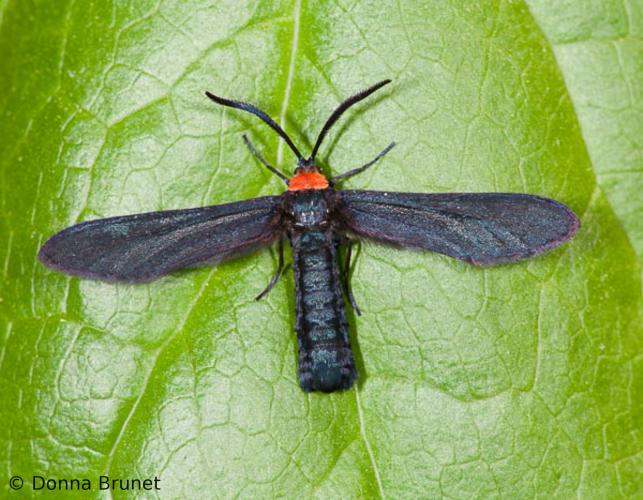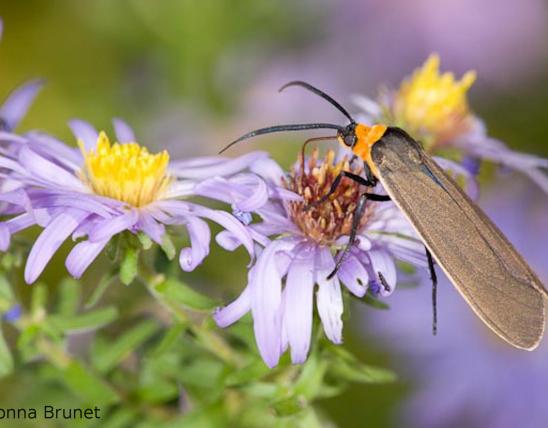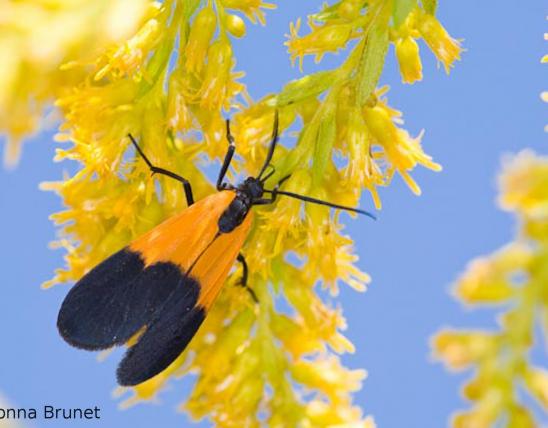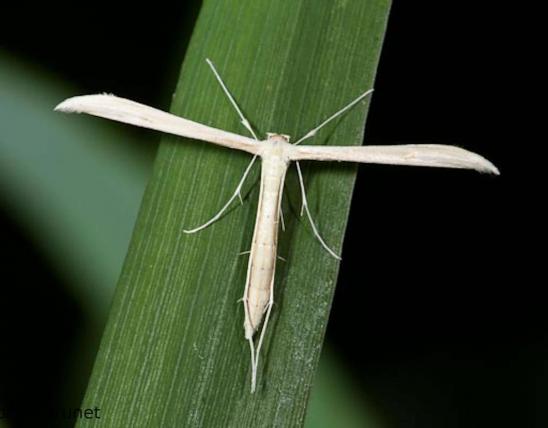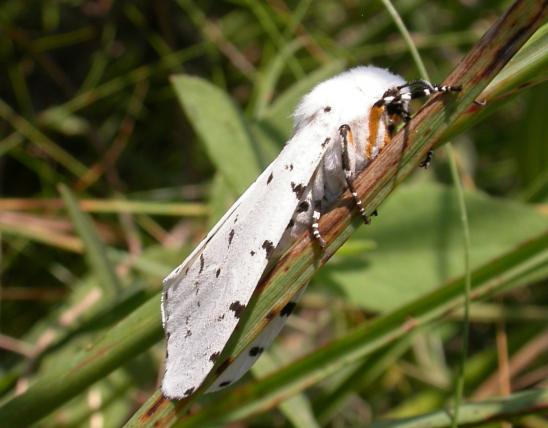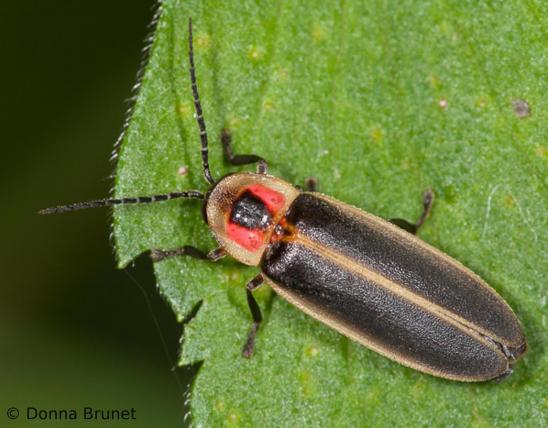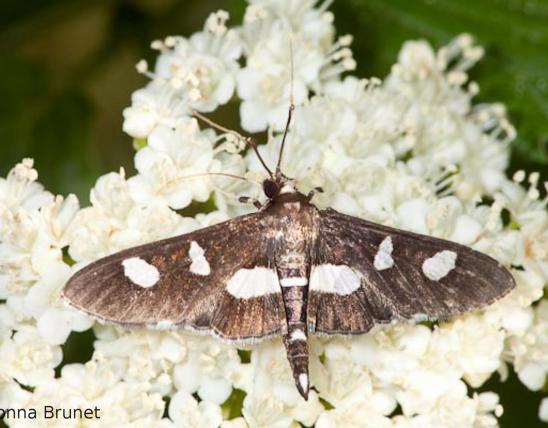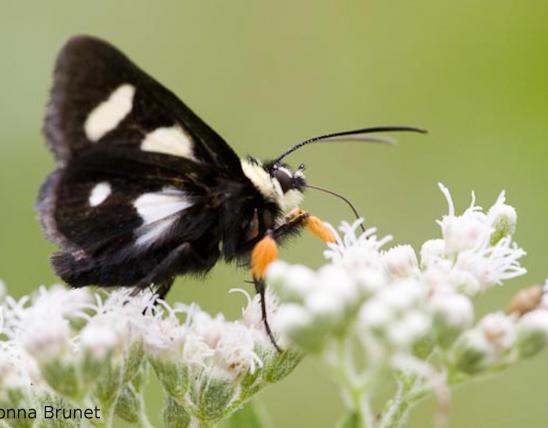
Adult grapeleaf skeletonizer moths have completely black wings that they typically hold flat, away from the body. An unbroken collar of red or orange is behind the black head. Both males and females have comblike (bipectinate) antennae; those of the males are feathery. The tip of the abdomen is expanded and curls upward, ending with a fanlike, two-parted tuft.
Mature larvae reach only about ½ inch in length. They are yellow, with an unbroken black band on each segment. Bristly hairs emerge in orderly clumps from each black band. In younger caterpillar stages, the black bands are broken into black spots. A few long white hairs protrude like cat whiskers from the front and rear of the caterpillars. The head is dark.
Use caution: the hairs or bristles on the caterpillars can cause a skin rash if you touch them.
Similar species:
- The so-called false skeletonizers (Acoloithus spp.) are smaller, and they have black color interrupting the middle of the orange collar; they also lack the fuzzy tufts at the abdomen tip.
- The yellow-collared scape moth (Cisseps fulvicollis), a type of tiger moth, has angular, less rounded wings, and its abdomen tip is rounded and not heavily covered with fuzzy-looking scales. It usually rests with its wings folded down to cover its body, not held out to the side.
- The Virginia ctenucha (Ctenucha virginica), another type of tiger moth, is larger and has a metallic blue body (including both abdomen and thorax) that contrasts with the brownish black of the wings. Its orange collar widens to extend more along the sides (“shoulders”) of the moth.
Wingspan: ¾–1¼ inches; length: ⅜–½ inch.
Statewide; occurs across the eastern United States and into Canada.
Habitat and Conservation
Adults may be active both at night and during the day and are often seen visiting flowers in fields. They fly from spring through fall in our area. Larvae may be found on plants in the grape family, usually feeding in groups on the undersides of leaves.
Food
As the name suggests, the caterpillars eat the leaves of various plants in the grape family, including Virginia creeper, raccoon grapes, and peppervine. They have also been recorded on redbud leaves. The caterpillars line up shoulder-to-shoulder to chew away the soft parts of leaves, leaving the tougher leaf veins behind (hence the name “leaf skeletonizer”). They usually stay on the undersides of leaves. The tiniest young caterpillars generally only eat the underside layers of the leaf, but as they grow larger, they eat almost the entire leaf except for the largest veins. As the caterpillars grow larger, they feed in smaller and smaller groups, then eventually move away as individuals to pupate. These are said to be the only caterpillars that feed on grape leaves in groups.
Adults live for only a few days. They sustain themselves by drinking nectar from flowers.
Status
The larvae can be pests on grape crops, but they are not considered as problematic as some other grape pests.
Life Cycle
There are likely 2 or more broods in Missouri. Like other moths, a member of this species begins life as an egg, hatches into a caterpillar, then has a number of larval molts, shedding its skin as it grows larger. When it reaches full size, it spins a silken cocoon attached to the back of a leaf, and pupates. Eggs hatch about a week after being laid, and about 6 weeks are spent as a caterpillar. The pupal “resting” stage lasts about 2 weeks, and adult moths live for only about 4 days. They overwinter as pupae.
Human Connections
If you own a vineyard or are even just growing grapes on a small scale, you probably don’t think highly of grapeleaf skeletonizers, which can defoliate grape plants. Keep in mind, however, that these caterpillars also gnaw away at Virginia creeper, raccoon grape, and other vigorous-growing native plants, serving an important role as a natural control on their growth.
If they have their choice among cultivated grapes, the caterpillars are said to prefer the most exotic and delicate varieties. Most authorities suggest handpicking them — especially effective when the caterpillars are still small and clustered together, before they disperse — or treating with Bacillus thuringiensis.
Ecosystem Connections
Bright colors warn predators of the ability of these moths to release toxic hydrocyanic acid from glands located on the head. Interestingly, unlike many other insects, moths in this family do not acquire their toxin from eating toxic plants; instead, their bodies manufacture it from the raw chemicals of their foods. Hydrocyanic acid is also present in the caterpillars and the eggs.
As with the adults, the caterpillars use bright colors to advertise their distastefulness. Staying together in a large group magnifies the visual effect of their colors. Also, as with a school of fish or herd of antelope, the clustering of larvae also decreases the chance of any one individual being the unlucky one that “educates” a predator about the species’ toxicity.
Note that there are several moths and other insects that have the same general look. In many species, the colors warn predators of toxic or distasteful chemicals, but several other species benefit from merely looking toxic. If a predator passes you by, the result is the same.
